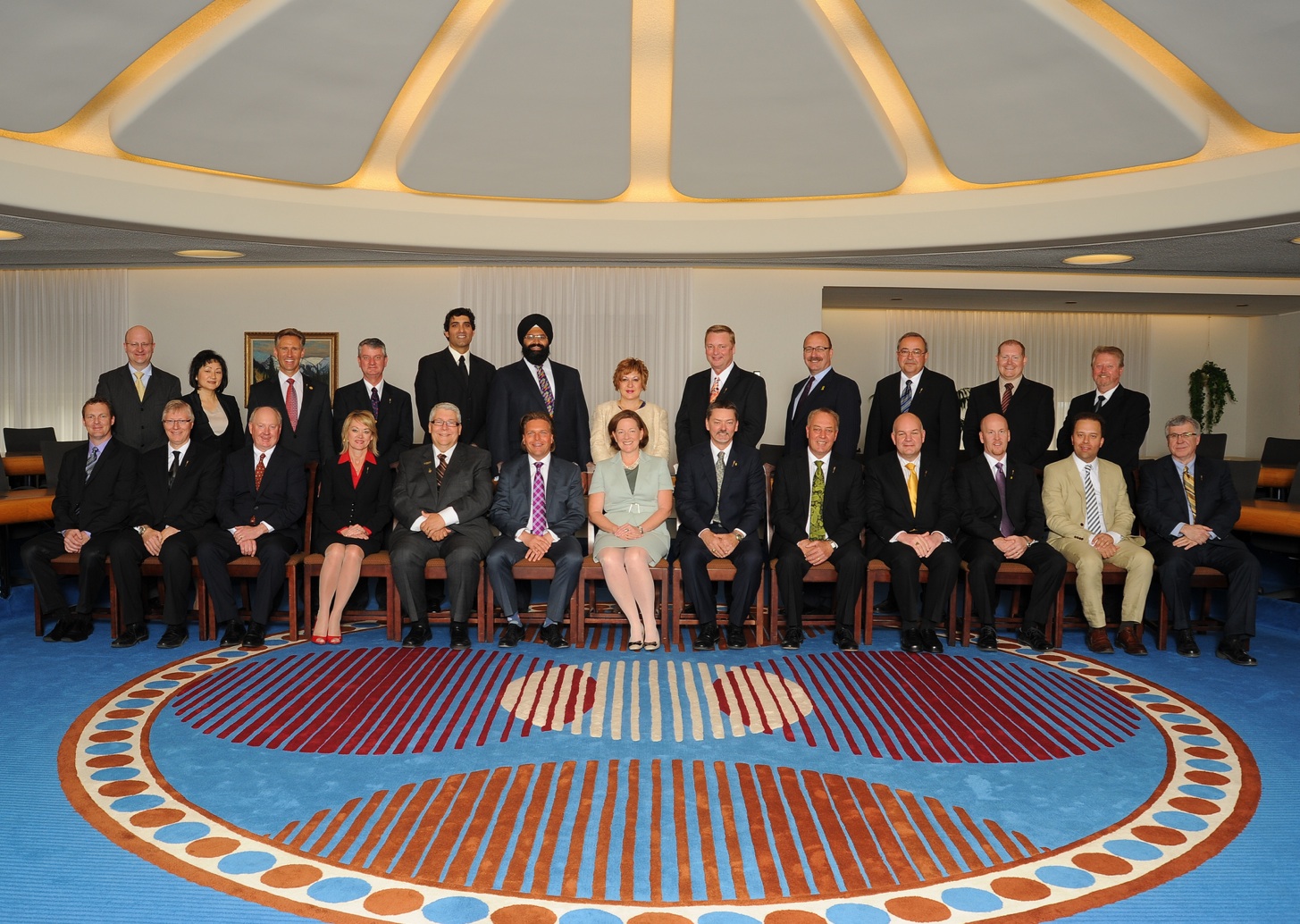With roughly 40 per cent of its members new to a cabinet role — and 15 per cent of them brand new to Alberta’s 87-seat Legislature — Premier Alison Redford’s new cabinet announced yesterday should have given the impression of more change than it did.
Despite the story the crunched numbers tell, though, this cabinet sure feels like the same old, same old.
The reason: so many of the key posts are still filled by the same key insiders. Just to name a few, Premier Redford herself, Doug Horner back at Finance, Dave Hancock back at Human Services, Fred Horne back at Health, Doug Griffiths back at Municipal Affairs, the ambitious Thomas Lukaszuk, now deputy premier, and even Energy Minister Ken Hughes, new to the Legislature but around forever in a string of influential jobs, most recently as chair of Alberta Health Services.
In other words, notwithstanding the way Redford announced the appointments yesterday afternoon — Holy Cow! By Twitter! Hold Page One! — nothing much of substance really changed in the makeup of the cabinet.
Still, you have to give her credit on a number of fronts.
No one is likely to be all that upset by her choices — certainly not anyone who was in her cabinet before and who was still an MLA after the unexpectedly mild carnage of election night, seeing as every single one of them is back in cabinet again.
Indeed, election night provided the premier with an opportunity — four old warhorses conveniently eliminated by the Wildrose Party, plus one who retired, requiring her to deliver no real bad news. Since there were no outright demotions from cabinet, and there were plenty of promotions, Redford is unlikely to have much problem with her own caucus.
But even her party’s opponents mostly won’t be too concerned by this reassuringly familiar feeling lineup. As suggested here yesterday, many progressively minded strategic voters may feel let down, but with this group most of them will reckon it’s still better than a wild-eyed Wildrose government under “Premier Danielle Smith” wielding the scissors.
Redford has also done a pretty good job of traditional cabinet balancing — unlike poor old Ed Stelmach, who muffed his first cabinet by forgetting about Calgary and thereby sparked a temper tantrum that got his government off on the wrong foot, where it pretty well remained until he left office.
In addition to the numbers crunched above, the A-Team cabinet has six members each from Calgary and metropolitan Edmonton. Over the total cabinet, it’s 9-6 in favour of Calgary, but many of the most important spots are occupied by Edmonton-area MLAs, so it all comes out in the wash.
The makeup of cabinet is about 70 per cent urban — which is about what it should be in a province like Alberta, past practice here notwithstanding. This suggests, as blogger Dave Cournoyer observed, that under Redford the Tories are finally going to grow up and start developing an honest-to-gosh urban agenda — and a strategy of confining the Wildrose Party to a rural rump.
Speaking of which, if the cabinet seems a little light on representation south of Alberta’s Mason-Dixon line, which runs east and west a little south of Calgary, well, one suspects Redford is saying, “Cry me a river!” They mostly voted Wildrose down that way, if you didn’t happen to notice.
Testosterone levels remain relatively high: 21 men to five women. But while there’s not much diversity in her caucus, Ms. Redford nevertheless made the effort to include three visible minority faces in her cabinet lineup.
Moreover, through a clever slight of hand, she has made it appear she is making her cabinet a little bit smaller while in fact making it quite a lot bigger. The mainstream media appears to have taken the bait along with the hook, line and sinker, and is reporting it just the way Redford’s press release would have them.
Her last cabinet had 21 ministers, which despite the campaign whinging by the far-right Wildrose Party, seems like a reasonable lineup for a province with a population of 3.5 million people and an economy the size and complexity of Alberta’s.
According to the government, this cabinet has 19 members. But it also has seven “associate ministers,” some with their own portfolio responsibilities, bringing the total to 26.
Sorry, but the distinction between Redford’s 19-member A-Team and the seven member B-Team is almost meaningless. These are not Parliamentary Secretaries as of old. They have responsibilities of their own, presumably they sit at the cabinet table and get extra pay for their efforts. This is a 26-member cabinet.
You have to admire Redford for finding a way to have her cake and eat it too on the issue of cabinet size. Members of the Opposition will yell at her about the bigger cabinet, but most Albertans won’t care.
Interestingly, Redford has eliminated the government caucus standing policy committees — a lame idea Ralph Klein transplanted from Calgary City Council and tried to graft onto the Parliamentary system. They cost a lot and did little. No one will miss them.
Summary? The deck chairs on the Titanic have been successfully rearranged. No icebergs are in sight.
The Redford Cabinet, Mark II
The A-Team
Alison Redford, Premier
Thomas Lukaszuk, Deputy Premier, Chair, Operations Committee
Doug Horner, Treasury Board, Finance
David Hancock, Human Services
Cal Dallas, International and Intergovernmental Relations
Diana McQueen, Environment and Sustainable Resource Development
Fred Horne, Health
Ken Hughes, Energy
Jeff Johnson, Education
Verlyn Olson, Agriculture
Jonathan Denis, Justice & Solicitor General
Doug Griffiths, Municipal Affairs
Robin Campbell, Aboriginal Relations
Heather Klimchuk, Culture
Manmeet Bhullar, Service Alberta
Wayne Drysdale, Infrastructure
Stephen Khan, Advanced Education
Ric McIver, Transportation
Christine Cusanelli, Tourism, Parks and Recreation
The B-Team
George VanderBurg, Seniors
Frank Oberle, Persons with Disabilities
Kyle Fawcett, Finance
Teresa Woo-Paw, International & Intergovernmental Relations
Greg Weadick, Municipal Affairs
Don Scott, Accountability, Transparency & Transformation
Dave Rodney, Wellness
This post also appears on David Climenhaga’s blog, Alberta Diary.




